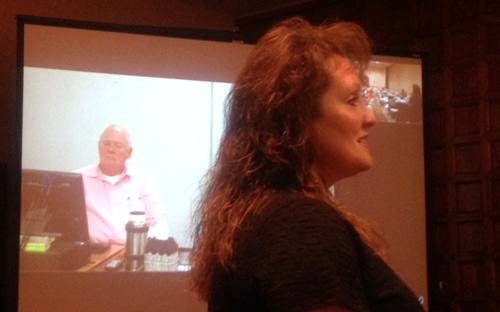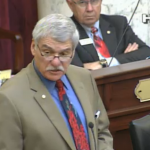Repeatedly — both before and after his election to a third term — Gov. Butch Otter’s praise for Idaho’s high school broadband system has focused on access.
The Idaho Education Network brings more classes into rural schools, he says, bringing the state that much closer to meeting its constitutional mandate to provide a uniform system of free public schools.
The state’s own numbers tell a very different story:
- From fall 2012 through spring 2014, 6,056 high school students took classes, using the Idaho Education Network’s video teleconferencing equipment. But more than half of these students attended only five of the state’s 115 school districts: West Ada, Bonneville, Cassia County, Twin Falls and Weiser.
- This list of online education “hotspots” includes three large districts, including West Ada, the state’s largest district. But this fall, these districts accounted for about 18,700 ninth- through 12th-graders — or 22 percent of the state’s total. In other words, these districts’ online enrollment numbers are high, relative to overall enrollment.
- In the spring of 2014, only 34 districts provided online classes over the network, down from 50 in the fall of 2012.
- The districts not providing Idaho Education Network classes include four of the state’s 10 largest districts: Nampa, Coeur d’Alene, Idaho Falls and Vallivue. But usage is also spotty in the state’s rural districts — those that most need online options to bolster curriculum. Only 13 of Idaho’s 50 smallest high school districts offered online courses in last spring.
The numbers were released a week ago, as part of a Legislative Services Office audit. The numbers come directly from the network itself; the network maintains a tally of classes “offered and received via video teleconferencing” on the network.
The release of the data comes at a pivotal juncture for the network. In the next few weeks, legislators will have to decide whether to spend another $8.9 million to keep the network online through June 30, 2016 — as Otter requested in his Jan. 12 budget request. And it comes as the embattled network is in turmoil, with its 2009 contract voided in a Boise district court, and with federally administered funding on hold amidst the legal battle.
Where it works
Depending on your perspective, Weiser High School is an outlier — or a textbook example of how this system was expected to work in small-town Idaho.
At this farming community near the Oregon border, students can take an ACT preparation class from West Side High School, some 300 miles away. They can take dual-credit classes from the College of Southern Idaho. One student parlayed a programming class from Twin Falls High School into admission into the prestigious Carnegie Mellon University in Pittsburgh — after helping the district troubleshoot some of its IT issues.

Weiser’s teachers offer Spanish classes to north-central Idaho’s Potlatch High School. Michelle Chavez’s class in Holocaust literature is available this semester to students in Murtaugh and Melba. Chavez has become something of a case study in Idaho’s online learning debate; in June, before legislators heard an update on the broadband funding impasse, they heard a remote testimonial from Chavez.
Weiser’s online enrollment numbers are startling. From fall 2012 through spring 2014, 376 Weiser students took classes over the Idaho Education Network — a high number in a district with only 458 ninth- through 12th-graders.
So when the audit report hit the street last week — replete with statistics about unused and missing equipment — Weiser Superintendent Wil Overgaard and high school principal Dave Davies wrote their local legislators to tell them that three network-connected classrooms are in constant use at Weiser.
“We just wanted to make sure our story wasn’t lost in the report,” Overgaard said Thursday.
In the Bonneville district surrounding Idaho Falls, classes are offered from school to school. Every day, Bonneville High School broadcasts Western civilizations, psychology and sociology courses to Hillcrest High School, which broadcasts a German course back to Bonneville.
“It’s hard to justify one teacher for a course when you aren’t servicing many students,” Bonneville Assistant Principal Levi Owen said. “This allows us to share and maximize our teaching resources in a way that is cost effective.”
However, since Bonneville’s network-capable classrooms are at full capacity, it does not offer classes outside the district.
Where it doesn’t work
Bonneville’s approach is not unique. A larger district, such as West Ada, may have incentive to use the network to offer classes from school to school, said former Senate Education Committee Chairman John Goedde. Unfortunately, he said, these districts have no incentive to offer their classes to other districts.

Hired last month as Otter’s point man on the broadband fiasco, Goedde acknowledges that the usage is spotty. “It is vital to some districts, and it is optional in others.” But he also believes the state is seeing just the tip of the iceberg, with the early adopters jumping into offering online classes.
The audit sheds some light on the problem.
In an anonymous survey, school administrators and technology coordinators are asked to comment on the network. Several administrators praised the broadband infrastructure itself, saying their districts wouldn’t be able to obtain similar service on their own. But they also said access to broadband doesn’t ensure access to new classes.
“The idea of having this equipment available for students is truly incredible,” said one respondent. “However, the lack of training provided and the limited class times made it very difficult for our students to take advantage of it.”
Another respondent complained of logistical and technological obstacles. “We struggle with the class times. Our bell schedule does not match those of other schools. We don’t have funding for a proctor in the classroom. Sometimes we have to shut it down and boot it back up. It can pixilate and does not flow smoothly sometimes. We have dropped calls from time to time. The picture of the teacher is very clear, but not of the students.”
In Weiser, Davies has a different point of view.
The technology works well, he said, and contractors fix any glitches quickly.
And his school has juggled remote classes across different districts, and even different time zones, by being flexible. Teachers who lead online classes have to be willing to work with students who have different class and vacation calendars. Teachers have to make allowances when a student misses the start of a in-house class period, or has to duck out early for the start of an online class.
“We look at it as, we’re adding something by altering our schedule,” he said. “It does have to be a priority.”
Idaho Education News reporter Nate Sunderland contributed to this report.
